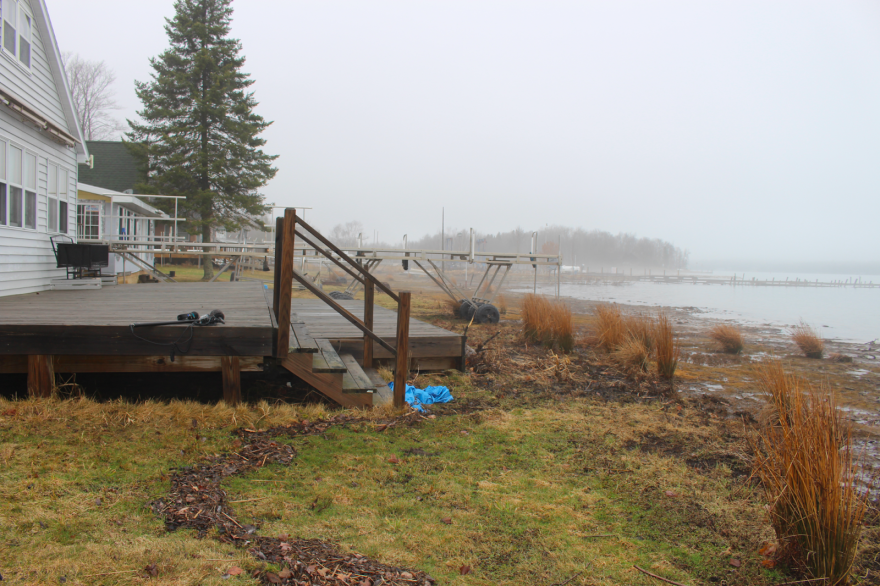About twenty people turned out for the April town hall meeting in Bruce Township. That might not sound like a lot, but it’s a big crowd for the small community on the eastern edge of the Upper Peninsula, a few miles south of Sault Ste. Marie. The area has a lot of older people. It feels like everyone knows each other.
A resident proposed reducing the speed limit along a busy stretch of road where she lives. Then, the latest report from the Fire Department — just one fire from someone cooking sap in their garage.
But the reason most people showed up was because of erosion along the shoreline.
“We all know this is a natural disaster, no different than a tornado or hurricane,” said Kris Clark when it came time to discuss the issue. She’s a retired nurse whose family has lived on the water in the area for generations.
Bruce Township sits along a narrow stretch of the St. Marys River. It’s the artery that connects the waters of Lake Superior to the rest of the Great Lakes.
Over the last few summers, water levels reached record highs. Yards and septic systems flooded. Docks washed away. And homeowners racked up thousands of dollars in damages.

Clark says the issue isn’t just the water level. The river has always fluctuated up and down. What’s different now is commercial shipping. Boats are bigger and heavier. They displace a lot of water and if they go fast enough, a swell of water follows in their wake.
“We can’t do anything about the high waters, but we can do something about the speed of the boats,” Clark said. “I hope. But I don’t know where to turn. And you can see by the turnout tonight, we’re all very concerned about this.”
The county where the township sits — Chippewa County — has one of the highest flooding risks in Michigan. Nearly one in five homes is susceptible to flood damage.
In some stretches along the St. Marys River, almost every homeowner has had problems.
Like Pat Lightfoot, who lives in an unincorporated community called Barbeau. He lost over a hundred feet of his wooden dock last year when a freighter came by. “Just totally gone,” he said. “We had to spend $15,000 on a rollout dock.”

He showed me his property on a misty morning the next day. He lives in a ranch with a wooden deck facing the river.
For the last two summers his yard has been entirely underwater. “At the height of it, you step off the step, you’re in the water,” Lightfoot told me.
The ground between the river and his house is soggy. Our rain boots squished in the muck.
Lightfoot says just about all of his neighbors’ yards have caved in. He knows their properties well because he mows their lawns every summer. The erosion has meant he’s had less mowing to do. “I made out like a bandit last year,” he admitted.
But the swamped yards have caused problems, like flooded septic systems for many of his neighbors. Whenever they flush their toilet, the water gurgles or it doesn’t go down, he said.
This year, the flooding might not be as bad. Water levels on the river are way down.
“Now if it stayed like this, they’d be fine,” he said. “But getting it to stay like this — I don’t know who has a good word with the man upstairs.”

To protect their homes, people along the river have built break walls or fortified the shoreline with chunks of concrete or boulders over the past few years. To do that requires several permits and money. And not everyone can afford the costs.
At the town hall meeting, one homeowner said he was quoted $30,000 to 40,000 to install a break wall. He didn’t have the money, he said.
So some residents are asking for help.
“They have to do something about the speed limit and there has to be something to help us put our property back together,” said Clark, the retired nurse.
She lives in a tidy house a few miles up the river from Lightfoot.
She’s gone to township meetings across the region and contacted local politicians and her representatives in Congress. So far though, nothing’s happened.
“Everybody agrees that it's terrible and then it just dies,” she told me. “You just feel a little impotent when you don’t get anywhere.”
Repairing septic systems or building seawalls isn’t covered under flood insurance, and she hasn’t found another source of funding to help cover costs.

For the boat speeds, local or state governments don’t have control over the commercial vessels that cause most of the issues. They’re regulated by the U.S. Coast Guard.
And the agency doesn’t think speed limits need to come down, according to Lieutenant Barton Nanney, the public affairs officer with the Coast Guard at Sault Sainte Marie.
“While I wouldn’t say it’s impossible, it depends on many different factors,” he said.
Nanney said the U.S. Army Corps of Engineers would need to step in and deem existing speed limits unsafe. (A representative from the Army Corps told IPR that the decision would be up to the Coast Guard.)

Meanwhile, Nanney said if homeowners think commercial boats are speeding, they should call the Coast Guard’s Vessel Traffic Service.
But residents like Clark and Lightfoot said they have called the Coast Guard, many times. Lightfoot said he keeps reaching an impasse.
“Every time I call them they tell me, ‘Nothing we can do.’”



